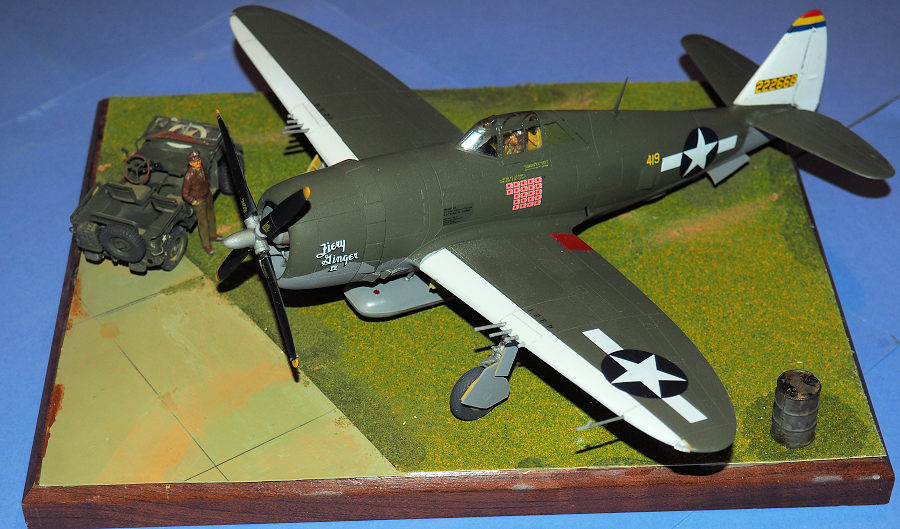
Hasegawa 1/48 P-47D Thunderbolt
| KIT #: | 04904 |
| PRICE: | $40.00 |
| DECALS: | two options |
| REVIEWER: | Mark Rossman |
| NOTES: |
The engine detail is minimal, but allows for the front view of the radial engine. Used TS-27 pure white for the tail, first undercoat of AS-20 Insignia White, this worked well to prevent bleed through. |

| HISTORY |
“Col. Neel Kearby” – “Fiery Ginger”
Final Mission
The P-47 was an outstanding escort and ground attack aircraft and was the heaviest and largest single seat fighter built during WWII. It rose out of a humble beginning which saw its ancestors the P-35 and P-43 fall short of expectations.
Early on the “Jug” was used as an escort to the ETO heavies, but was replaced as the P-51 came on-line; its best role was that of a ground attack aircraft both in the ETO, MTO, PTO and CBI theaters. P-47’s was used by the U.S., British, French, Mexican, Brazilian and Russian air forces.
Col. Neel Kearby was born June 5, 1911, in Wichita Falls Tx. Kearby graduated from University of Texas at Arlington with a Bachelors degree in Business Administration. He enlisted into the Army Air Corps in 1937, training at Randolf and Kelly Airfields.
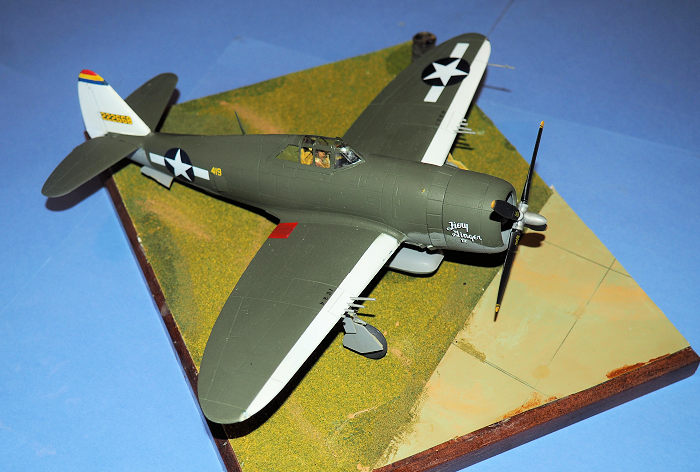 Col.
Kearby served with the 94th and 40th Pursuit Squadrons at Selfridge Field, then
in December of 1940 commanded the 14th Pursuit Squadron at the Panama Canal,
flying P-39’s. October of 1942, he was transferred to the 348th FG at Westover
Field Ma., taking command with the rank of major. Many months of training in the
new P-47 brought the group to Australia, in June of 1943, now with Kearby a Lt.
Colonel.
Col.
Kearby served with the 94th and 40th Pursuit Squadrons at Selfridge Field, then
in December of 1940 commanded the 14th Pursuit Squadron at the Panama Canal,
flying P-39’s. October of 1942, he was transferred to the 348th FG at Westover
Field Ma., taking command with the rank of major. Many months of training in the
new P-47 brought the group to Australia, in June of 1943, now with Kearby a Lt.
Colonel.
Kearby’s tactics utilized the P-47’s turbo charger to fly at high altitude, then diving on the lightly armored Japanese planes, using eight(8) deadly .50-Caliber machine guns. He opened his score on September 4, 1943 with a Ki-43 fighter and GM4 bomber. He was then promoted to full Colonel on September 23. Kearby named his plane “Fiery Ginger” after his wife, Virginia, and all subsequent P-47’s. (Fiery Ginger I through IV).
In January 1944, General McCarther pinned the Medal of Honor on Kearby, for his actions on October 11th, 1943. Leading four Thunderbolts on a fighter sweep over Wewak, they encountered 40 enemy aircraft. The ensuing battle saw Kearby destroy four(4) Ki-43’s and two(2) Ki-61’s making him the first P-47 ace of the PTO and claiming the record for the most shoot downs by an A.A.F. pilot in a single mission. That was surpassed by Mustang pilot Lt. Shomo, shooting down seven(7) in January 1945. General Kenney recommended him for the Medal of Honor.
In November of 1943, Kearby was transferred to headquarters of the 5th AF, with 12 victories. Continuing to fly missions whenever he could, he was closing in on becoming the leading A.A.F. ace in the Pacific, hoping to break Rickenbacker’s WWI record.
On March 5, 1944 at 4:00pm, a mission took off from Saidor Airfield, piloted by Col. Neel E. Kearby leading a fighter sweep over Wewak with P-47D pilot Captain "Dinghy" Dunham and P-47D pilot Captain Samuel V. Blair. At 5:15pm flying at 22,000' the P-47s reached Dagua and saw the “Nells” flying at roughly 500' in a "V" formation. The bombers spotted them and began to descend to the west following the north coast of New Guinea. The P-47s closed to an altitude of 200' and Col Kearby fired on the lead bomber causing it to pull up on fire then dive into the ground. He was credited for a "Nell", Ki-48 Lily, his 22nd aerial victory claim. Meanwhile, Captain Dunham fired at the Ki-48 Lily on the left and caused it to crash in flames. The third bomber was attacked by Blair and crashed into the ground and exploded.
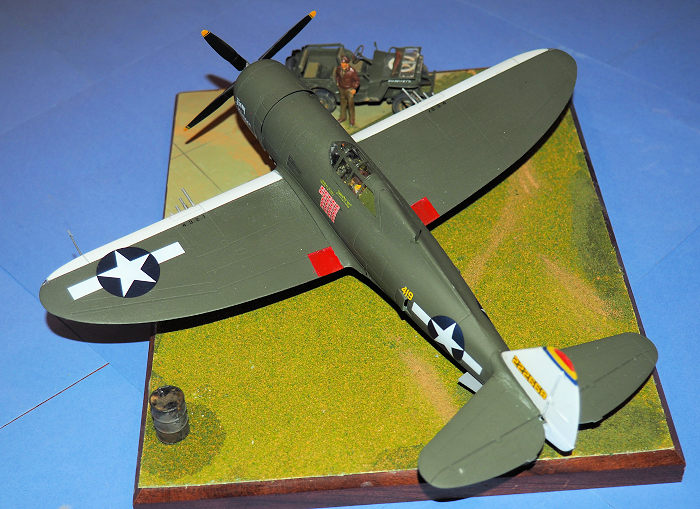 Intercepting
again, Kearby fired on a bomber but did not observe it to go down and made a
turn to setup for another attack. At 5:20pm, while turning, Kearby was
intercepted by a Ki-43 Oscar from 77th Sentai and never seen again. When this
aircraft failed to return it was officially listed as Missing In Action (MIA).
Kearby was damaged from gunfire of the Ki-43 Oscar, he managed to bail but
became tangled in a tree and died of bullet wounds. Damaged, his P-47 crashed
into the jungle inland from Dagua.
Intercepting
again, Kearby fired on a bomber but did not observe it to go down and made a
turn to setup for another attack. At 5:20pm, while turning, Kearby was
intercepted by a Ki-43 Oscar from 77th Sentai and never seen again. When this
aircraft failed to return it was officially listed as Missing In Action (MIA).
Kearby was damaged from gunfire of the Ki-43 Oscar, he managed to bail but
became tangled in a tree and died of bullet wounds. Damaged, his P-47 crashed
into the jungle inland from Dagua.
Afterwards, Dunham and Blair called for Kearby on the radio but received no answer at 5:30pm they departed for Saidor Airfield. After landing, both pilots insisted on returning to the area to search for him, Dunham had to be physical restrained from taking off again.
During 1946, Kearby's remains were recovered by a Royal Australian Air Force (RAAF) Searcher Team then turned over to the U.S. Army, then shipped to the United States for permanent burial. Kearby was listed as MIA until 1948, then officially declared dead the day of the mission.
On June 16, 1949 Kearby was buried at Hillcrest Memorial Park, Dallas Texas at Garden of Devotion Block 13 Lot 19 Space 7 & 8. He is also memorialized on a plaque for Congressional Medal of Honor recipients at Cape Wom Memorial Park near Wewak.
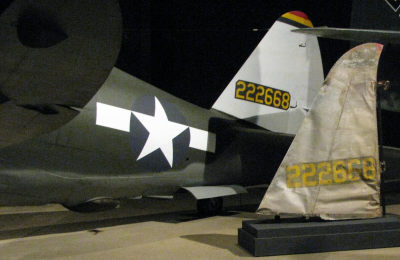 During
2001, the tail section and a .50 caliber machine gun were recovered by Robert
Greinert / HARS and shipped to Sydney. then placed into storage at HARS at
Sydney Airport (Mascot).
During
2001, the tail section and a .50 caliber machine gun were recovered by Robert
Greinert / HARS and shipped to Sydney. then placed into storage at HARS at
Sydney Airport (Mascot).
During 2003, the salvaged items were donated to the National Museum of the United States Air Force (USAF Museum) and put on public display in 2005. Both are displayed with P-47D Thunderbolt 42-23278 painted in the markings of this aircraft. The tail section is displayed atop a base and the machine gun is displayed inside a glass display case. This is my picture of it from my visit in 2013.
| THE MODEL |
This is a Hasegawa P-47 Razorback, the kit represents a Razorback very well with the build taking about 2 weeks. The engine detail is minimal, but allows for what is seen thru the front an accurate portrayal of the radial engine. The flaps and control surfaces are all molded in place. If you want to show off the cockpit area an aftermarket cockpit interior would be better to use.
The decal positioning was easy to follow, although looking at pictures
it was important to get the Grey and O.D. demarcation correct, on the cowling,
as the ‘IV’ is in the grey area and the rest in the O.D. Using pure
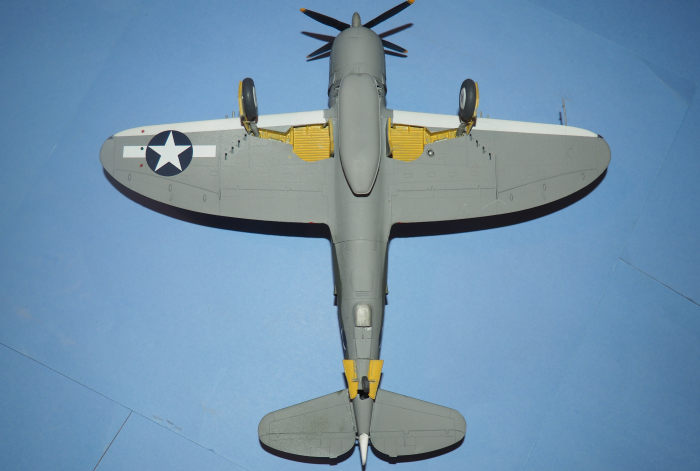 white for the
tail, I used an undercoat of AS-20 Insignia White, this worked well to prevent
bleed through. I masked off the tail to paint the striping rather than using the
decal.
white for the
tail, I used an undercoat of AS-20 Insignia White, this worked well to prevent
bleed through. I masked off the tail to paint the striping rather than using the
decal.
Note: After the block number, Evansville aircraft were identified by the -RE suffix, while Farmingdale aircraft were given the -RA suffix.
Aircraft: ‘Fiery Ginger IV’, P-47D-4-RA, 42-222668 – Lost over Dagua.
Unit: 348th FG, V Fighter Command, Saidor Airfield, New Guinea - March 1944.
Pilot: Col. Neel Kearby (KIA) – CO 348th FG
Model: Hasegawa 09404; P-47D Razorback 1/48th
Decals: THUNDERCALS – 48002 – Razorback Thunderbolts Pt 2.
Paint:
Tamiya sprays: AS-6 Olive Drab, AS-7 Neutral Grey, TS-27 – Pure White, AS-20
Insignia White, TS-34 Camel Yellow, TS-15 Blue, TS-86 Pure Red,
| REFERENCES |
Decal Sheet
P-47 Thunderbolt with the USAAF in the MTO, Asia and Pacific – SMI Library (Kagero)
//pacificwrecks.com/aircraft/p-47l
Osprey Aircraft of the Aces - #26 “Mustang and Thunderbolt Aces of the pacific and CBI.”
Picture of Kearby’s recovered tail was taken by me at the USAF Museum Dayton Ohio in 2014. Was present for my daughter’s graduation as a Flight Nurse, for the 109Th Air Medical Wing MnGuard.
20 May 2024 Copyright ModelingMadness.com. All rights reserved. No
reproduction in part or in whole without express permission from the editor. If you would like your product reviewed fairly and fairly quickly, please
contact the editor or see other details in the
Note to
Contributors.